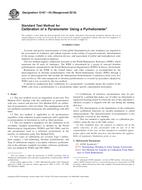Wir benötigen Ihre Einwilligung zur Verwendung der einzelnen Daten, damit Sie unter anderem Informationen zu Ihren Interessen einsehen können. Klicken Sie auf "OK", um Ihre Zustimmung zu erteilen.
ASTM G167-05(2010)
Standard Test Method for Calibration of a Pyranometer Using a Pyrheliometer
Automatische name übersetzung:
Standard -Testverfahren für die Kalibrierung eines Pyranometer Verwendung eines Pyrheliometer
NORM herausgegeben am 1.12.2010
Informationen über die Norm:
Bezeichnung normen: ASTM G167-05(2010)
Anmerkung: UNGÜLTIG
Ausgabedatum normen: 1.12.2010
SKU: NS-57501
Zahl der Seiten: 21
Gewicht ca.: 63 g (0.14 Pfund)
Land: Amerikanische technische Norm
Kategorie: Technische Normen ASTM
Die Annotation des Normtextes ASTM G167-05(2010) :
Keywords:
ICS Number Code 07.060 (Geology. Meteorology. Hydrology)
Ergänzende Informationen
| Significance and Use | ||||||||||
|
The pyranometer is a radiometer designed to measure the sum of directly solar radiation and sky radiation in such proportions as solar altitude, atmospheric conditions and cloud cover may produce. When tilted to the equator, by an angle β, pyranometers measure only hemispherical radiation falling in the plane of the radiation receptor. This test method represents the only practical means for calibration of a reference pyranometer. While the sun-trackers, the shading disk, the number of instantaneous readings, and the electronic display equipment used will vary from laboratory to laboratory, the method provides for the minimum acceptable conditions, procedures and techniques required. While, in theory, the choice of tilt angle (β) is unlimited, in practice, satisfactory precision is achieved over a range of tilt angles close to the zenith angles used in the field. The at-tilt calibration as performed in the tilted position relates to a specific tilted position and in this position requires no tilt correction. However, a tilt correction may be required to relate the calibration to other orientations, including axis vertical. Note 1—WMO Fist Class pyranometers, or better, generally exhibit tilt errors of less than 1 % to tilts of 50° from the horizontal. Traceability of calibrations to the World Radiometric Reference (WRR) is achieved through comparison to a reference absolute pyrheliometer that is itself traceable to the WRR through one of the following: One of the International Pyrheliometric Comparisons (IPC) held in Davos, Switzerland since 1980 (IPC IV). See Refs (3-7). Any like intercomparison held in the United States, Canada or Mexico and sanctioned by the World Meteorological Organization as a Regional Intercomparison of Absolute Cavity Pyrheliometers. Intercomparison with any absolute cavity pyrheliometer that has participated in either and IPC or a WMO-sanctioned intercomparison within the past five years and which was found to be within ±0.4 % of the mean of all absolute pyrheliometers participating therein. The calibration method employed in this test method assumes that the accuracy of the values obtained are independent of time of year, with the constraints imposed and by the test instrument's temperature compensation circuit (neglecting cosine errors). |
||||||||||
| 1. Scope | ||||||||||
|
1.1 This test method covers an integration of previous Test Method E913 dealing with the calibration of pyranometers with axis vertical and previous Test Method E941 on calibration of pyranometers with axis tilted. This amalgamation of the two methods essentially harmonizes the methodology with ISO 9846. 1.2 This test method is applicable to all pyranometers regardless of the radiation receptor employed, and is applicable to pyranometers in horizontal as well as tilted positions. 1.3 This test method is mandatory for the calibration of all secondary standard pyranometers as defined by the World Meteorological Organization (WMO) and ISO 9060, and for any pyranometer used as a reference pyranometer in the transfer of calibration using Test Method E842. 1.4 Two types of calibrations are covered: Type I calibrations employ a self-calibrating, absolute pyrheliometer, and Type II calibrations employ a secondary reference pyrheliometer as the reference standard (secondary reference pyrheliometers are defined by WMO and ISO 9060). 1.5 Calibrations of reference pyranometers may be performed by a method that makes use of either an altazimuth or equatorial tracking mount in which the axis of the radiometer's radiation receptor is aligned with the sun during the shading disk test. 1.6 The determination of the dependence of the calibration factor (calibration function) on variable parameters is called characterization. The characterization of pyranometers is not specifically covered by this method. 1.7 This test method is applicable only to calibration procedures using the sun as the light source. 1.8 This standard does not purport to address all of the safety concerns, if any, associated with its use. It is the responsibility of the user of this standard to establish appropriate safety and health practices and determine the applicability of regulatory limitations prior to use. |
||||||||||
| 2. Referenced Documents | ||||||||||
|



 Cookies
Cookies
